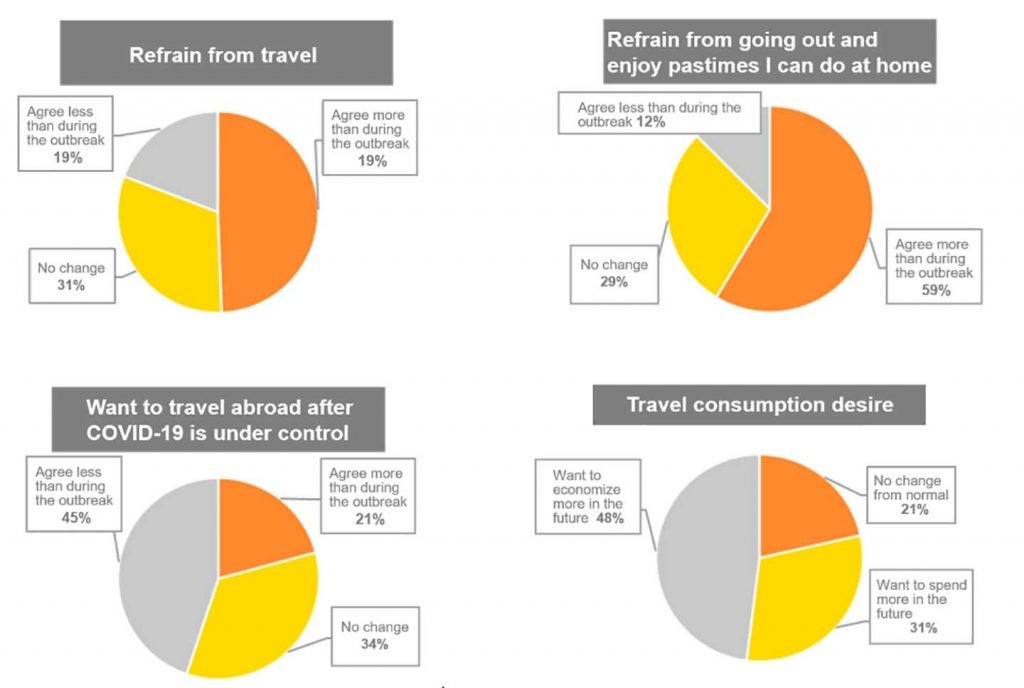Hakuhodo Institute of Life and Living Shanghai Chief Researcher Tetsuo Yamada explains the attitudes and behavior of sei-katsu-sha (holistic consumers) in a China that has gradually restarted economic activities since March, leading the world into the post–COVID-19 period.
Beginning with the unprecedented lockdown of Wuhan on January 23, strict restrictions on life and economic activities were implemented across China, leaving Chinese sei-katsu-sha (people that live lives that include behaviors and feelings rooted in latent desires and values toward products, purchasing and every aspect of their lifestyles) with no choice but to wait things out at home. Thanks to this, most of the country, except Hubei Province and a few other places, was able to bring the epidemic under control by late February without the longer lockdowns introduced in other countries.

In Shanghai, where the Hakuhodo Institute of Life and Living Shanghai (HILL Shanghai) is located, working at the office recommenced on February 24, with work getting back to normal from March. Restaurants reopened early, too, and were filled with white-collar workers. Even in Wuhan, the lockdown was lifted on April 8, and it’s said that 115 million Chinese traveled during the five-day May Day holiday. Nevertheless, given that 195 million people traveled during last year’s three-day May Day holiday, it is clear that the impact of COVID-19 was significant.
Additionally, some entertainment facilities, such as cinemas and theaters, are still unable to resume business, and in education, remote learning for lower elementary school graders and university students continued until the end of May. Moreover, there has been news of clusters of infection in Jilin and Beijing, among other locations, so even in June, it is still not possible to let our guards down.
The advent of “cloud travel” and “delivery gravesite visits” as vigilance about travel continues
I’d now like to introduce some case studies from the post–COVID-19 period. One of the things people wanted to do once freed from isolation at home is travel. Since it is still not possible to travel abroad, this inevitably means domestic travel, but with many wary of using public transportation like trains, buses and planes, driving holidays using their own cars are proving popular. For those not able to travel by car, it is now possible to enjoy the sensation of travel with “cloud travel.” Participants enjoy the feeling of traveling with others in real time via live streaming, with trips to climb Everest and visit Potala Palace proving popular.
During the Qingming Festival holiday (April 4–6)—when Chinese would normally visit gravesites, pray to their ancestors, and make ritual offerings—such services as “cloud gravesite visits,” where visits took place online, and “delivery graveside visits,” where people paid someone else to visit, were also popular. One 500 yuan (approx. US$70) “delivery gravesite visit” package included grave visit essentials such as joss paper money, flowers, tombstone cleaning, bowing to the tomb, and even a proxy lamentation service.
Many respondents in HILL Shanghai’s May survey agreed that they still Refrain from travel and Refrain from going out and enjoy pastimes they can do at home even though COVID-19 has been brought under control, while few agreed that they Want to travel abroad after COVID-19 is under control. With the results also showing that travel is something respondents Want to economize more in the future, the travel and leisure industry has turned to online services, while putting effort into connecting that to their business.

Bricks and mortar stores also chasing sales through livestreamed “live commerce”
One industry affected massively by the coronavirus is, unsurprisingly, retail businesses with actual stores. However, “live commerce,” or the livestreamed selling of goods, is robust among retailers with real stores. Live commerce, a new style of ecommerce where celebrities and influencers showcase products live and viewers can leave real-time questions and comments as they buy them. The market has grown in China to the point where one influencer can sell US$2.9 million worth of product in two hours.
Today, live commerce featuring regular sales people instead of celebrities is spectacularly successful, and hugely popular, as it allows people to buy products at great prices “for a short time only.” With real stores reinventing themselves as showrooms and studios as their necessity is questioned as a result of the growth of ecommerce, live commerce is further advancing the integration of real and online stores.
HILL Shanghai research found that in comparison to before COVID-19, live commerce shopping increased slightly during the outbreak and after it had subsided.

Luxury and high-end brands targeting young “Installment Celebs” en masse
Since prior to the coronavirus outbreak, luxury brands in China had been shifting the thrust of their sales to younger targets. The massive impact of the coronavirus shock on the luxury brand industry has seen it accelerate measures targeting young people in an effort to turn sales around.
You might be wondering why high-end brands and young people. Reasons include the extreme ease of using virtual credit cards like Huabei and Baitiao provided by Alipay and other ecommerce platforms, as well as more active purchasing of even big-ticket items in installments, as though by subscription, as a result of now frequent sales promotions offering interest- and fee-free installment plans to stimulate purchasing.
At HILL Shanghai, we call young sei-katsu-sha that purchase in installments things that are beyond their means Installment Celebs, and such sei-katsu-sha are becoming targets for high-ticket consumption in China.
One change in luxury brand communication targeting young people is the many advertisements that use anime and virtual idols. The use of key opinion leaders (KOLs) popular among young people is also widespread, and even Japanese and German luxury car brands are using male idols known as “xiăo xiān ròu” (“young fresh meat,” meaning good-looking, successful young men) as their brand spokespeople and undertaking other such communication that would be unthinkable in other countries.
China today is aging rapidly, but even still, the consumer power of young people is evident. According to HILL Shanghai research, the majority of users of the virtual credit cards Huabei and Baitiao are in their 20s and 30s, and with this age group accounting for around half of those who agreed that they shop beyond their means, it is clear that the Installment Celebs cohort is vivifying luxury consumption.


Chinese sei-katsu-sha’s mindsets remain “under COVID-19,” while companies try to shift to a “post–COVID-19” footing—The common ground: Both are trying to strike first
As I’ve outlined, Chinese sei-katsu-sha still very much retain the guardedness they exhibited when the coronavirus was spreading while, conversely, companies are trying various tricks to stimulate sei-katsu-sha’s desire to shop in an effort to reawaken the economy and shift it into a post–COVID-19 footing.
Belying this vigilance, people are also upskilling and developing themselves to help them overcome the coming economic crisis, with the fact that rental study rooms are not only being used by students but adults as well coming under the spotlight recently. HILL Shanghai research indicates that a Want to make preparations with the future in mind mentality is widespread, with scores for Online learning, Investing/Asset management/Saving, and Taking out a commercial insurance policy remaining robust, even since the coronavirus has subsided.


Not only are Chinese sei-katsu-sha proactively taking self-protective measures against a second wave of the virus, they are preparing for inevitable future changes by steadily starting to “strike first.” Meanwhile, companies, too, are trying new tactics to turn their businesses around as quickly as possible from the hit they took due to the COVID-19 shock. Another “strike first” stance, this effort to stimulate consumer demand continues.
What a Japan that is currently working to bring the coronavirus under control can learn from Chinese sei-katsu-sha and companies is that flexibly accepting whatever happens without getting bogged down and striking first is the way to get on board with the “new normal.”
About the author
 Since joining Hakuhodo in 1995, Tetsuo Yamamoto has been involved in client marketing in general, and has experience in a wide array of disciplines, from communications to business development. He began new activities in June 2018 as a member of HILL Shanghai.
Since joining Hakuhodo in 1995, Tetsuo Yamamoto has been involved in client marketing in general, and has experience in a wide array of disciplines, from communications to business development. He began new activities in June 2018 as a member of HILL Shanghai.







